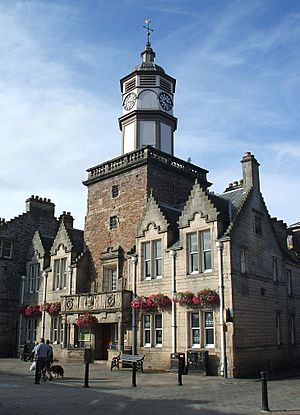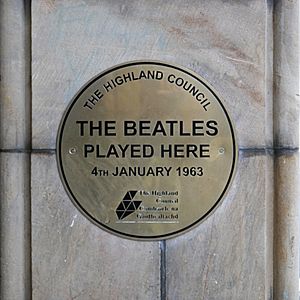Dingwall Town Hall facts for kids
Quick facts for kids Dingwall Town Hall |
|
|---|---|

Dingwall Town Hall
|
|
| Location | High Street, Dingwall |
| Built | 1745 |
| Architect | Mr Downie |
| Architectural style(s) | Neoclassical style |
|
Listed Building – Category B
|
|
| Official name: High Street, Town Hall | |
| Designated | 25 March 1971 |
| Reference no. | LB24506 |
| Lua error in Module:Location_map at line 420: attempt to index field 'wikibase' (a nil value). | |
Dingwall Town Hall is an old and important building in Dingwall, Scotland. It's on the High Street. This building used to be where the town's leaders met and where some people were held. Now, it's a museum! It's also a special "Category B listed building," which means it's protected because of its history and architecture.
Contents
History of Dingwall Town Hall
Building a New Town Hall
Back in 1729, the leaders of Dingwall (called "burgh leaders") decided the town needed a new building. This building would be for important town meetings. It would also be a place to hold people who broke the law. They chose a spot where a town citizen, Alexander Dingwall, lived. He was given another place to live.
The new building was designed by a Mr. Downie. It was built like a "tolbooth," which was a type of town hall that often included a jail. A local builder named William MacNeill built it using "rubble masonry." This means he used rough, uncut stones. The building was finished in 1745.
What the Building Looked Like
The original design of the Town Hall was quite grand. It had a main front with five sections facing the High Street. The middle section had steps leading up to an entrance on the first floor. Above this, there was a square stone tower called "the steeple."
On the ground floor, there were doorways on either side of the main entrance. There were also windows in the outer sections. Inside, the main rooms were on the first floor. The town council met in a room on the left, and a courtroom was on the right. The ground floor was used as a "lock-up" (a small jail). The steeple held a prison for people who owed money.
Changes Over the Years
In 1773, the steeple got a new look. A tall, eight-sided wooden tower, called a "cupola," was added. Donald McNeil built it, following a design by John Boag. The clock for this new tower was a gift to the town. It came from Major-General John Scott, who used to be a Member of Parliament for the area.
The building was changed again in 1905 by William Cumming Joass. He added "stepped gables" to the sides of the building. These are decorative wall sections that look like steps. He also added a central entrance area with columns. These columns supported a decorative band (an "entablature") and a balcony.
Famous Visitors and Events
The rooms in the Town Hall were often used for public events. Many famous people visited! The rock band The Beatles even played a concert there on January 4, 1963. However, only 19 people came to see them! Most people in town went to see a local band, The Melotones, at another venue that night. Another famous rock band, Slade, played a concert at the Town Hall on November 14, 1970.
The Town Hall was also a place for important political events. In the 1983 general election, a future leader of the Liberal Democrats party, Charles Kennedy, was announced as the local Member of Parliament right there in the Town Hall. A Member of Parliament is someone elected to represent their area in the country's government.
From Town Hall to Museum
The building continued to be the main office for the town council for many years. But in 1975, a larger local government area was created. The Town Hall was no longer the main government building for Dingwall.
At that time, the building became the home of the Dingwall Museum. The museum has many interesting things to see. It includes a recreated "smithy," which is a workshop where a blacksmith works with metal. There's also a room dedicated to the life of Major-General Hector MacDonald. He was a famous soldier who fought in the Battle of Omdurman in 1898.
See also


